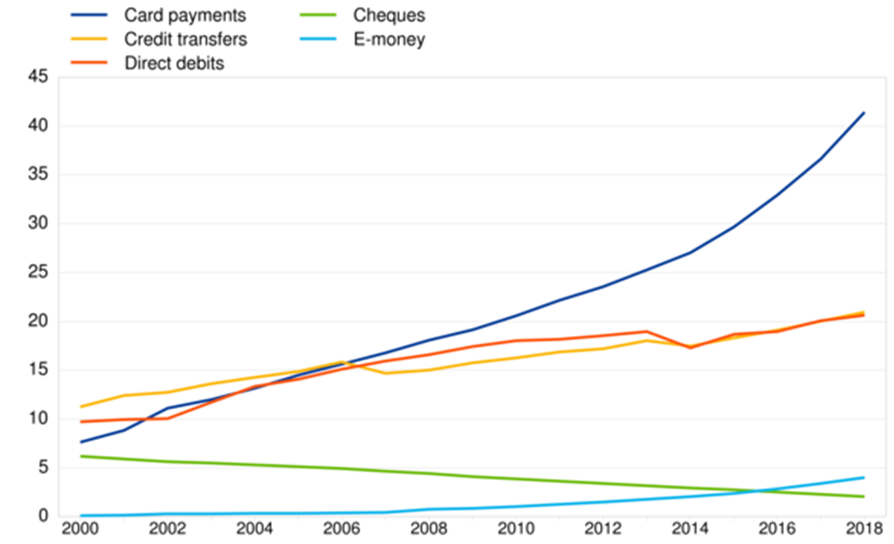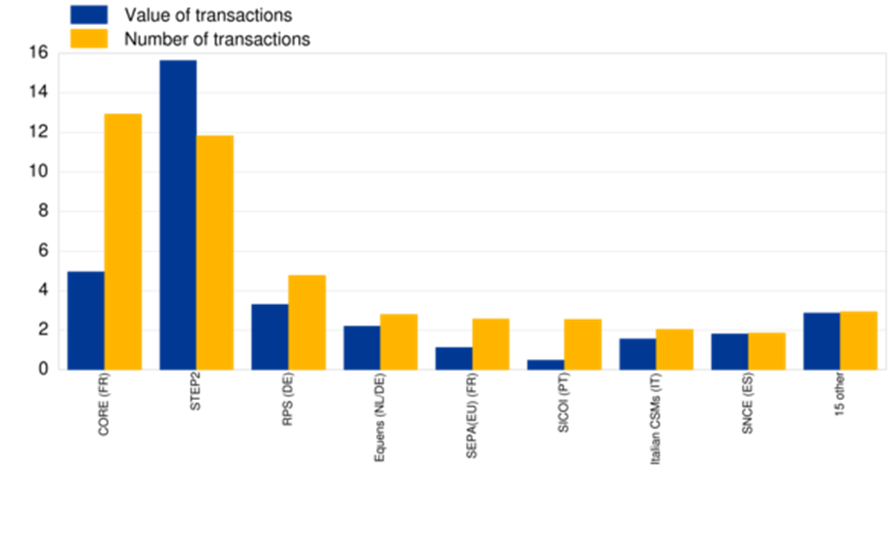- Press release
- 26 July 2019
Payments statistics: 2018
- The total number of non-cash payments in the euro area increased by 7.9% to 90.7 billion in 2018 compared with the previous year.
- Card payments accounted for 46% of the total number of non-cash payments in the euro area, while credit transfers and direct debits accounted each for 23%.
- The number of payment cards issued (544 million) represented around 1.6 payment cards per euro area inhabitant.
- Around 44 billion transactions were processed by retail payment systems in the euro area with an amount of €34.0 trillion.
The European Central Bank (ECB) has today published the 2018 statistics on non-cash payments, which comprise indicators on access to and use of payment services and terminals by the public, as well as volumes and values of transactions processed through payment systems. While this press release focuses on developments in the euro area as a whole, statistics are also published for each EU Member State, in addition to EU and euro area aggregates and comparative data.
Payment services[1]
The total number of non-cash payments in the euro area, comprising all types of payment services[2], increased by 7.9% to 90.7 billion in 2018 compared with the previous year. Card payments accounted for 46% of all transactions, while credit transfers and direct debits accounted each for 23%.
The number of credit transfers within the euro area increased in 2018 by 4.7% to 21.0 billion. The relative importance of transactions initiated electronically continued to increase, with the ratio of transactions initiated electronically to paper based transactions now standing at around eleven to one.
The number of cards in the euro area with a payment function increased in 2018 by 4.0% to 544.0 million. With a total euro area population of 341 million, this represented around 1.6 payment cards per euro area inhabitant. The number of card transactions rose by 13.0% to 41.4 billion, with a total value of €1.8 trillion. This corresponds to an average value of around €44 per card transaction. Chart 1 below shows the development in the use of the main payment services in the euro area from 2000 to 2018.
The relative importance of the main payment services continued to vary widely across euro area countries in 2018. For example, the highest national percentage for card payments is displayed by Portugal at around 71%, the highest national percentage for credit transfers is found in Slovakia at around 44% and Germany accounts for the highest national percentage for direct debits at around 47% (see Annex).
In 2018, the total number of automated teller machines (ATMs) in the euro area decreased by 0.3% to 0.30 million, while the number of point of sale (POS) terminals increased by 11.2% to 10.5 million.
Use of the main payment services in the euro area
(number of transactions per year in billions, estimated) Source: ECB.Note: Data have been partially estimated for periods prior to 2010, as methodological changes were implemented in previous years and some corresponding data are not available. The historical estimation done by the ECB ensures comparability of figures over the entire period. Statistics are also collected on other payment services, which accounted for 1.8% of the total number of euro area transactions in 2018.
Retail payment systems
Retail payment systems in the euro area handle mainly payments that are made by individuals, with a relatively low value, high volume, and limited time-criticality.
In 2018, data have been reported for 23 retail payment systems within the euro area as a whole. During the year, around 44 billion transactions were processed with a combined value of €34.0 trillion[3].
There continues to be a notable degree of concentration in euro area retail payment systems in 2018. The three largest systems in terms of number of transactions (CORE in France, STEP2[4] and RPS in Germany) processed 67% of the volume and 70% of the value of all transactions processed by euro area retail payment systems. Chart 2 shows the number and value of transactions processed by euro area retail payment systems in 2018.
Retail payment systems in the euro area in 2018
(value of transactions in EUR trillions and number of transactions in billions) Source: ECB. 
Large-value payment systems
Large-value payment systems (LVPSs) are designed primarily to process large-value and/or high-priority payments made between participants in the system for their own account or on behalf of their customers. Although, as a rule, no minimum value is set for payments made in such systems, the average size of such payments is usually relatively large. During 2018, three systems settled 142 million payments with a total value of €489 trillion in euro payments, with TARGET2 and EURO1/STEP1 being the two main LVPSs[5].
Chart 3 below shows the number and value of transactions processed by the main LVPSs in 2018.
Main large-value payment systems in 2018
(value of transactions in EUR trillions (left-hand scale) and number of transactions in millions (right-hand scale)) Source: ECB. 
Annex
Relative importance of the main payment instruments in the euro area countries (2018)
For media queries, please contact Stefan Ruhkamp, tel.: +49 69 1344 5057.
Notes:
- The full set of payment statistics can be downloaded from the Statistical Data Warehouse (SDW). The "Reports" section of the SDW also contains pre-formatted tables with payment statistics for the last five years. The data are presented in the same format as in the former "Blue Book Addendum". For detailed methodological information, including a list of all data definitions, please refer to the "Statistics" section of the ECB's website.
- As a result of the progressive implementation of the Single Euro Payments Area (SEPA) and other developments in the payments market in Europe, the methodological and reporting framework for payments statistics has been enhanced as of the reference year 2014. The new requirements are laid down in the Regulation on payments statistics (ECB/2013/43) and in the Guideline on monetary and financial statistics (recast) (ECB/2014/15). A background note, available on the ECB's websitedescribes the changes in more detail.
- In addition to annual payments statistics for 2018, this press release incorporates minor revisions to data for previous periods. The hyperlinks in the press release are dynamic; thus, the data might slightly change with the next annual release due to revisions. Unless otherwise indicated, statistics referring to euro area cover the EU Member States that had adopted the euro at the time to which the data relate.
- [1]SEPA instruments are included in the respective categories. Information on the SEPA instruments can be found on the ECB's website (http://www.ecb.europa.eu/paym/sepa/html/index.en.html).
- [2]Including credit transfers, direct debits, card payments with cards issued by resident payment service providers, e-money payments, cheques and other payment services.
- [3]The figures for one Cypriot payment system are excluded from the euro area aggregates due to confidentiality.
- [4]STEP2 is a pan-European automated clearing house for retail payments in euro operated by EBA CLEARING.
- [5]TARGET2 is the second-generation Trans-European Automated Real-time Gross settlement Express Transfer system. It is operated by the Eurosystem and settles payments in euro in central bank money.
Banque centrale européenne
Direction générale Communication
- Sonnemannstrasse 20
- 60314 Frankfurt am Main, Allemagne
- +49 69 1344 7455
- media@ecb.europa.eu
Reproduction autorisée en citant la source
Contacts médias

